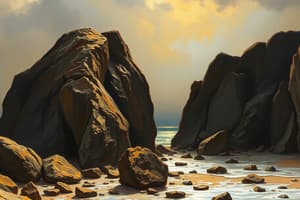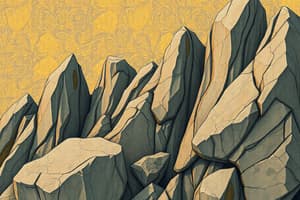Podcast
Questions and Answers
What is a rock?
What is a rock?
A rock is an aggregate of mineral or minerals which may or may not contain organic matter.
Which of these descriptions correctly defines the rock cycle?
Which of these descriptions correctly defines the rock cycle?
- A method of mineral extraction.
- A process that only applies to igneous rocks.
- A model showing how rocks are formed and reformed. (correct)
- A type of mineral composition.
What are the three types of rocks?
What are the three types of rocks?
- Igneous, Metamorphic, Sedimentary (correct)
- Chemical, Physical, Biological
- Lava, Magma, Glass
- Granitic, Basaltic, Obsidian
How are igneous rocks formed?
How are igneous rocks formed?
What is the process of weathering?
What is the process of weathering?
What distinguishes foliated metamorphic rocks?
What distinguishes foliated metamorphic rocks?
Which of the following processes leads to the formation of sedimentary rock?
Which of the following processes leads to the formation of sedimentary rock?
What is a mineral?
What is a mineral?
Water is considered a mineral.
Water is considered a mineral.
Obsidian is formed from the slow cooling of magma.
Obsidian is formed from the slow cooling of magma.
Flashcards are hidden until you start studying
Study Notes
Rock Formation and the Rock Cycle
- Rocks are aggregates of minerals, which may or may not contain organic matter.
- The geosphere is constructed of various types of rocks.
- The rock cycle is a model illustrating the formation, breakdown, and transformation of rocks into different types.
- Any type of rock can serve as a raw material for another.
Types of Rocks
- Igneous Rocks: Formed from the cooling of molten magma. Can be categorized into:
- Intrusive Igneous Rocks: Form in Earth’s interior with slow cooling, creating larger crystals.
- Extrusive Igneous Rocks: Form on Earth's surface with rapid cooling, resulting in smaller crystals.
- Sedimentary Rocks: Formed from the accumulation of pre-existing rocks and organic fossils.
- Metamorphic Rocks: Formed from existing rocks subjected to heat and pressure.
Formation of Igneous Rocks
- Cooling of magma or lava leads to the formation of igneous rocks.
- Quenching: Rapid cooling of molten rock creates a glassy texture, exemplified by volcanic glass like obsidian.
- Igneous rocks are grouped based on mineral content:
- Felsic (Granitic) Rocks: Light-colored minerals.
- Basaltic (Mafic) Rocks: Dark gray to black minerals.
Formation of Sedimentary Rocks
- Weathering: Breaks down rocks into smaller fragments, occurring physically or chemically.
- Erosion: Transports unconsolidated materials through natural agents such as wind, water, and organisms.
- Deposition: Settlement of materials in one location.
- Lithification: Process where sediments turn into sedimentary rocks through compaction and cementation.
Formation of Metamorphic Rocks
- Classified based on foliation, which refers to the orientation of mineral grains.
- Two types exist:
- Foliated Metamorphic Rocks: Show clear layers formed under stress, typically near plate boundaries.
- Non-foliated Metamorphic Rocks: Lack distinct layers, forming in areas of minimal deformation.
Key Points
- Rocks are aggregates of minerals and can be categorized as igneous, sedimentary, or metamorphic based on their formation processes.
- The rock cycle emphasizes the interrelationship between different rock types.
- Ice and snowflakes are debated as minerals due to their crystalline structure and natural occurrence.
Minerals
- Defined as naturally occurring, inorganic solids with a definite chemical composition and ordered crystalline structure.
- Physical properties of minerals include:
- Color: Determined by light wavelengths reflected.
- Streak: The color of a mineral in powdered form.
- Luster: The appearance or sheen of a mineral's surface.
Studying That Suits You
Use AI to generate personalized quizzes and flashcards to suit your learning preferences.




